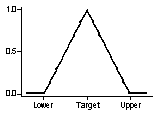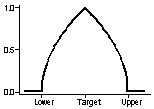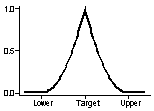The weight determines how the desirability is distributed on the interval between the lower (or upper) bound and the target. It determines the shape of the desirability function that is used to translate the response scale to the zero-to-one desirability scale to determine the individual desirability of a response.
You can select a weight from 0.1 to 10 to emphasize or de-emphasize the importance of hitting the target value:
- A weight = 1 places equal importance on the target and the bounds. This is a neutral setting.
- A weight > 1 places more emphasis on the target. Increasing the weight requires the response to move closer to the target to achieve a specified desirability.
- A weight < 1 places less emphasis on the target. Decreasing the weight does not require that the response move as close to the target.
The following figures show how various weights affect the shape of the desirability function. Desirability is on the y-axis and the response is on the x-axis.

Weight =1

Weight =0.5

